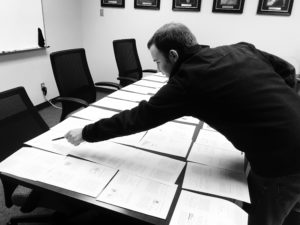On February 20, 2020, Will Scholten successfully defended his Ph.D. dissertation entitled “A Novel Uncoupled Method for Static Aeroelastic Analysis Towards MorphingStructures Design,” making him the first Ph.D. student to be independently advised by Hartl to successfully complete his degree requirements and graduate.


Will Scholten carefully reviews a final draft of his dissertation with Dr. Hartl just prior to his Ph.D. defense.
Will first began working with Hartl as a sophomore undergraduate student, eventually completing his first archival paper published in AIAA Journal before completing his B.S. degree. Dr. Scholten went on to win the prestigious NSF Fellowship, which allowed him to develop a completely new approach to analyzing structures undergoing very large deformations in the presence of fluid flows. Eventually, Will’s careful attention to detail and natural engineering and research abilities culminated in a number of impressive achievements, and his methods were recently adapted by the Army Research Laboratory.
The full text of his dissertation abstract is as follows:
“Fluid-structure interaction (FSI) analysis is a common tool used to analyze aeroelastic problems. The traditional FSI scheme couples independent structure and fluid solvers in space and time. For many aerospace applications the final equilibrium configuration of the structure is of interest, which can only be obtained by incrementally iterating the fluid and structure solvers until convergence is obtained. The high computational cost associated with conducting a single FSI analysis can make conducting aero-structural design studies infeasible.
This work develops a new method for conducting FSI analysis that greatly expedites design studies. This new scheme, referred to as the uncoupled FSI method, removes the necessarily serial interaction of the structure and fluid solvers. Instead of running a single serially coupled analysis, the uncoupled FSI method evaluates many decoupled structural and fluid analyses for given displacement and pressure fields, these evaluations being highly parallelizable. Surrogate modeling of the results from these two evaluation classes allows an interpolative calculation of their intersection; this is proposed to represent the solution of the FSI analysis. This work will demonstrate that the proposed uncoupled FSI method results in accurate solutions for a range of FSI problems and that it can be incorporated in optimization schemes, enabling new possibilities for aero-structural design.”
